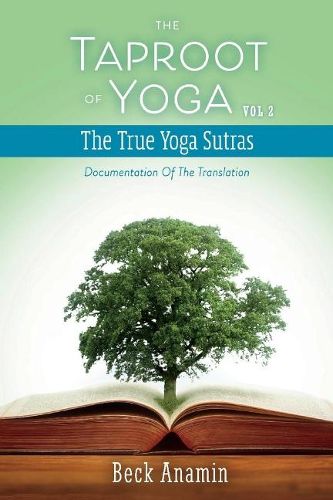Readings Newsletter
Become a Readings Member to make your shopping experience even easier.
Sign in or sign up for free!
You’re not far away from qualifying for FREE standard shipping within Australia
You’ve qualified for FREE standard shipping within Australia
The cart is loading…






The Sanskrit for Patanjali’s Yoga Sutras has existed unchanged for more than 2000 years. Purported ‘translations’ and interpretations do exist, but they are robustly entangled with and distorted by the influence of personal beliefs and the continually accumulated teachings of yoga cultures and religions. This Yoga Sutras book is unique: it avoids those errors by using definitions contemporary with Patanjali, deliberately shunning modern influences.This second volume of The Taproot of Yoga, The True Yoga Sutras responds to the practical, intellectual, and moral obligation to be transparent about the translation process. Its presence should reassure readers that the translation from the Sanskrit has been conducted carefully and caringly. Further it is present for those who wish to use a detailed reading to verify its accuracy, learn more about the modern interpretations, or critique its contents. No Modern Yoga Sutras author has provided similar documentation. For each of 196 sutras this second volume discusses the translation process and how the other books arrived at their versions. The translation of each word is shown. Where the word, or its sutra, differs from that of any author(s), the difference is analyzed and documented, often providing the opportunity to show why and how the difference came about. Out of respect, no author name appears in this analysis. The use of modern definitions for Sanskrit words, rather than a definition contemporary with Patanjali, was a frequent cause of error in the current books. Even more dangerous to accurate translation, certain important words in the modern versions came from the Hindi/Urdu dictionary. A problem common to multiple authors arises from substituting religious god names for the ‘Supreme Being’ of the original. Similarly, using a gender of ‘He in the place of the neutral 'it’ or ‘that’ changes the viewpoint. Many authors translated the meanings of multiple sutras around the eight ‘occult powers,’ which Hinduism had not yet stated during Patanjali’s time. In more than a few cases, authors seem to have molded their interpretations around an established modern model. Accomplishing substitution of the model for translation required adding, deleting, or mistranslating words. Translation frequently included, or warped toward, what were clearly personal beliefs. The exact copying of erroneous wording across authors was worrisome. Further, rather than translating, authors sometimes used wrong interpretations said to come from an iconic early mystic such as Vyasa. Those are just a sampling of the translation problems. In combination, the result is the production of Modern Yoga Sutras books that are greatly different from this original. In addition to modern sutras being incorrect, the original has a core theme completely unrecognized in modern yoga and pattern strings that weave through the core theme.
$9.00 standard shipping within Australia
FREE standard shipping within Australia for orders over $100.00
Express & International shipping calculated at checkout
The Sanskrit for Patanjali’s Yoga Sutras has existed unchanged for more than 2000 years. Purported ‘translations’ and interpretations do exist, but they are robustly entangled with and distorted by the influence of personal beliefs and the continually accumulated teachings of yoga cultures and religions. This Yoga Sutras book is unique: it avoids those errors by using definitions contemporary with Patanjali, deliberately shunning modern influences.This second volume of The Taproot of Yoga, The True Yoga Sutras responds to the practical, intellectual, and moral obligation to be transparent about the translation process. Its presence should reassure readers that the translation from the Sanskrit has been conducted carefully and caringly. Further it is present for those who wish to use a detailed reading to verify its accuracy, learn more about the modern interpretations, or critique its contents. No Modern Yoga Sutras author has provided similar documentation. For each of 196 sutras this second volume discusses the translation process and how the other books arrived at their versions. The translation of each word is shown. Where the word, or its sutra, differs from that of any author(s), the difference is analyzed and documented, often providing the opportunity to show why and how the difference came about. Out of respect, no author name appears in this analysis. The use of modern definitions for Sanskrit words, rather than a definition contemporary with Patanjali, was a frequent cause of error in the current books. Even more dangerous to accurate translation, certain important words in the modern versions came from the Hindi/Urdu dictionary. A problem common to multiple authors arises from substituting religious god names for the ‘Supreme Being’ of the original. Similarly, using a gender of ‘He in the place of the neutral 'it’ or ‘that’ changes the viewpoint. Many authors translated the meanings of multiple sutras around the eight ‘occult powers,’ which Hinduism had not yet stated during Patanjali’s time. In more than a few cases, authors seem to have molded their interpretations around an established modern model. Accomplishing substitution of the model for translation required adding, deleting, or mistranslating words. Translation frequently included, or warped toward, what were clearly personal beliefs. The exact copying of erroneous wording across authors was worrisome. Further, rather than translating, authors sometimes used wrong interpretations said to come from an iconic early mystic such as Vyasa. Those are just a sampling of the translation problems. In combination, the result is the production of Modern Yoga Sutras books that are greatly different from this original. In addition to modern sutras being incorrect, the original has a core theme completely unrecognized in modern yoga and pattern strings that weave through the core theme.